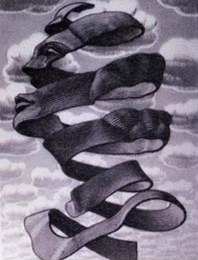"Art of Memory: Collective and Individual"

We all individually share the experience of memory. We all know our own memory. Our identity is the collection of memories that we have stored. We emerge from infancy once we can thread our memories into our own narrative. We worry when moments are lost from memory. We believe our memories to be stable and secure but eventually we must acknowledge that memories are constructed and re-constructed, edited and sanitized, and are not always congruent with the memories of others who were there. Collective memory is the crucial component of belonging to a group. We trace back our experiences by looking at our history. We write our histories, we create monuments and memorials, and we create social groups on the basis of shared memories.
In the Fall and Spring semesters of 2009 and 2010 the Lewis University History Center sponsored a faculty colloquium on the subject of memory. Memory is studied, collected, examined, molded and preserved in virtually every discipline in the College of Arts and Sciences. Biologists now have an image of a memory being formed in a firing synapse. Psychologists trace the impact of trauma in childhood on memory in the adults. They also examine how memory is stored collectively in cultures, such as the day of the dead memorials in Mexico. Historians deal with both individual memory, such as the oral memory of African-Americans emerging from slavery, as well as community memory of immigrants to Chicago who try to preserve the memory of their origins. Memories are stored in local churches and public monuments. But when we examine collective memories, problems emerge. Who controls what will be remembered? Church bombings in Alabama during the Civil Rights Movement reverberate in both individual and collective memory. The museums of Lithuania tell a story of a nation but they no longer include the memory of the Jews lost in the Holocaust of 1939-1945. Collective memory can be divided: Armenians and Turks share history but remember it differently. Maya and Ladino in Guatemala have a divided memory about their shared past.
Theologians deal with very deep cultural memories of profound events deep in the past which are nonetheless constantly renewed in each generation. The faithful return to sacred sites in acts of pilgrimage and they have been doing so since late antiquity. Today the pilgrim can venture into the virtual world of the internet for the spiritual equivalent of an actual journey. Chaucer used the pilgrimage to collect stories in the late Middle Ages.
In literature, modern novelists have created masterworks of stream-of-consciousness narratives in which we observe memory being formed and manipulated. Filmmakers use memory, the loss of memory, the reconstruction of memory as the basis of powerful stories, both individual and collective. Composers connect us to our past using their sound palate. Genealogists have learned how to access and preserve oral family memories.
Students at Lewis University had access to all presentations and films of the Art of Memory through the Arts and Ideas program. The Arts and Ideas calendar is published at the beginning of each semester and serves as a guide to the rich cultural and entertainment programming offered on campus. Additionally, the 2010 Windows publication, an annual compendium of student and faculty essays, art, photography, poetry and fiction featured “memory” as a theme. The December 2009 presentation of Art of Memory featured students from poetry classes who interpreted poems and presented their own work. This year long program gathered both a student and a community audience and we hope that this website will allow for an even broader audience for this novel format of thematically unified presentations.
The major sponsors for these presentations are the Lewis University History Center and the Arts and Ideas Program. The series was organized by Dr. Ewa Bacon, History, with the collaboration of the Lewis faculty participants. Our final presentation by Dr. Mooney-Melvin was also the annual History Department Vince Howard Memorial lecture, supported by Dr. Bonnie Bondavalli, Dean of the College of Arts and Sciences. Thanks go to Sue Sollie for providing technical support for the videotaping. Dr. Mike McFerron’s help has been unstinting, cheerful and invaluable in creating a critical component of our series: an electronic memory.
Our haiku poet is Angus Ogilvy, Edinburgh, Scotland:
-
I know I had it,
the perfect combination,
light and shadow; gone.
Last night's glass
abandoned on the table,
drained.
The book is finished;
now I am bereft, only
memory to cheer.
Opening the door,
I remember that last night
It would not open.
© Angus D.H. Ogilvy April 2009